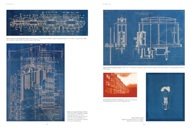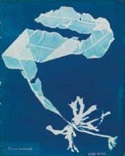b l u e p r i n t 2 0 1 3
c a t a l o g u e
A catalogue will be available for sale at various venues during the event. It is published by Glasgow Print Studio in conjunction with Street Level Photoworks. The contents are listed below:
Preface (included below)
Articles on:
Cyanotype: a Blueprint for Visual Vandalism? - Mike Ware
Photo-mechanical reproduction, industrial duplication and the machine aesthetic - Frances Robertson
The Carbon Process and Photogravure - Harry Magee & Roger Farnham
Gel Lithography - Roger Farnham
An Alumni Map - Roger Farnham & Frances Robertson
About:
The Scottish Society for the History of Photography
The archives & collections:
The University of Glasgow
Archive
Library Special Collection
Glasgow Libraries
Mitchell Library - The Glasgow Archive
Hillhead Library - The Electric Theatre
Glasgow Museums
Resource Centre (GMRC)
Riverside Museum
Institution of Engineering and Technology
IET Scotland
Teacher Building
The exhibitions:
Trongate 103
Glasgow Print Studio
Photography in Printmaking
Street Level Photoworks
Dreaming of Cyanotypes - the Yin and the Yang of image-making
RGI Kelly Gallery
George Wyllie: Scul?tor and Navigator
Hidden Lane Gallery
Palladium and Platinum Prints by Margaret Watkins and others
from the Clarence H White School of Photography
Further Reading
Preface
The original concept for b l u e p r i n t was to have two concurrent exhibitions, one in Street Level Photoworks, the second in the Glasgow Print Studio, which would explore the interfaces between ‘alternative’ photographic processes and fine art printmaking. The galleries had become next door neighbours in 2009, when Glasgow City Council created Trongate 103. The idea was to link the exhibitions by showing some of the technology which bridged their respective disciplines on the walls between the two galleries.
In researching examples of alternative photographic processes, it became evident that Glasgow Museums have one of the few extant sets of cyanotypes making up the first book with photographic illustrations, ‘Photographs of British Algae: Cyanotype Impressions’, by Anna Atkins. A visit to Glasgow’s Mitchell Library to see blueprint drawings held in the City Archive lead to Glasgow University’s Archive and the drawings for the ‘Big Loco’, which had recently become the star of the newly opened Riverside Museum. Discussion with the Scottish Society for the History of Photography (SSHoP) suggested that an engineering angle deserved deeper consideration and the project began to grow like Topsy; the two initial exhibitions turned into events involving six exhibitions, a Heritage Trail encompassing four archives and a museum, together with a number of lectures and talks.
As well as cyanotypes, carbon prints are also being exhibited; these make a neat tie-in with engineering as Joseph Swan, perfector of the carbon printing process, was also the man who perfected the light bulb a few years later and indeed went on to become the President of the Institution of Electrical Engineers. Another key alternative process, platinum/palladium printing, is represented in an exhibition of palladium prints by Margaret Watkins. At Glasgow Print Studio most of the printmaking processes which can create a photographically originated image are represented.
The notion of an all blue show was considered – pigment process prints can be any colour – but this was ‘moderated’ by the gallery directors and the criteria for inclusion became processes which predate ‘modern’ darkroom processes and which require a full size negative. b l u e p r i n t was originally conceived as a working title, however, the affection for the cyanotype process proved much greater than anticipated and b l u e p r i n t has prevailed. The organizers are also pleased that Dr Mike Ware, who will deliver the 2013 Annan Lecture, has risen to the challenge of the blue dilemma, entitling his lecture ‘Cyanotype: a Blueprint for Visual Vandalism?’
Returning to the original concept of the exhibitions and the notion of looking at the cross-over technologies, there are two particular examples - photogravure and gel lithography, both printing with ink processes - which are explored in some detail in articles in this catalogue. The Alumni map article is a Systems Engineering attempt at showing the relationships between the early pioneers of all these processes. The map shows various paths to final printing processes, in particular those for photogravure, from its roots in Mungo Ponton’s discovery of potassium bichromate as a photo-sensitizer, and gel lithography from its roots in Sir John Herschel’s identification of the light sensitivity of iron salts.
And we must not forget how the word blueprint entered the language. The original descriptive use of the word for the cyanotype process has come to have a new, more conceptual meaning. Its present usage as a term for strategic planning or design is attested by the Oxford English Dictionary to have been current since 1926 when a Spectator article referred to “blue-prints of the millennium”. Searching the on-line version of ‘The Guardian’ over the last 10 years, one finds a consistent use of the word in its modern meaning; the word is being used at least once a day with that meaning.
It is interesting that the modern meaning relates to the early stages of a project or idea, whereas originally, blueprints were made only when the design was complete, and multiple copies of the drawing were required for manufacturing and construction purposes. It is also a little ironic that the digital photography revolution has made it easier to make large negatives, which are a key component in making images in an alternative process.
This catalogue endeavours to create a legacy document for the project, reflecting a renewed interest in the photographic techniques used. It is hoped you will enjoy the exhibits on view in the various galleries and that the b l u e p r i n t project will also stimulate further interest in the rich resources held in local archives - particularly the sets of Anna Atkins’ cyanotypes and the volumes of ‘Camera Work’ - with lots of new work being created to celebrate the processes which have been highlighted.
Roger Farnham & Harry Magee
The catalogue is available from Glasgow Print Studio - also by mail order - and some of the the other venues.


